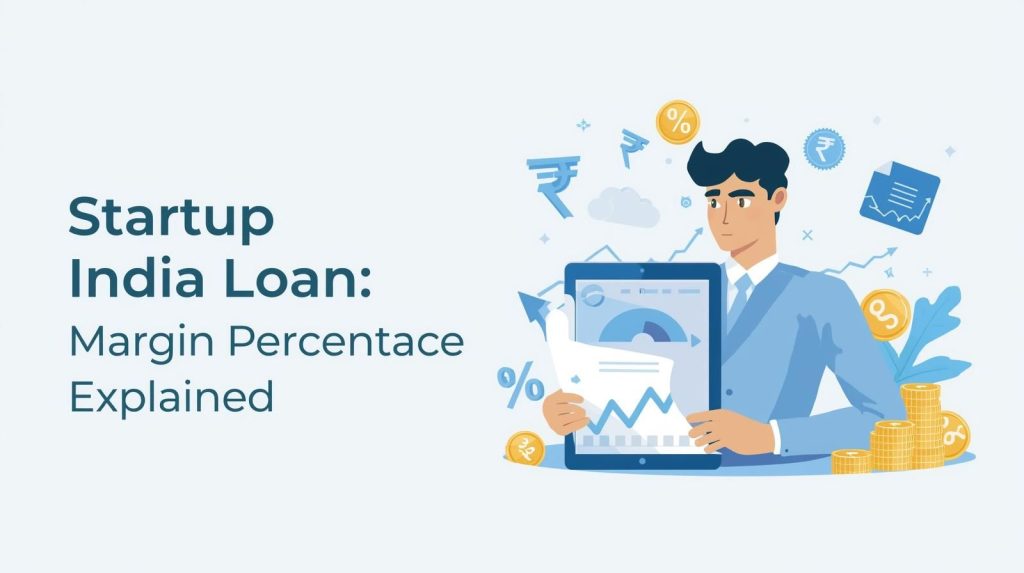Starting a business in India is both exciting and challenging. Entrepreneurs often face their first major hurdle when it comes to funding. While personal savings, family contributions, or angel investors play a role, government schemes such as the Startup India Loan have emerged as a lifeline for small businesses and first-time entrepreneurs.
One of the most common questions entrepreneurs ask is:
“What is the margin percentage in Startup India Loan?”
In simple words, margin percentage refers to the portion of the project cost that the borrower must contribute from their own funds, while the rest is financed by the bank or financial institution under the Startup India initiative.
This blog will explore in detail:
- The concept of margin money in loans.
- The margin percentage in Startup India loans.
- How it differs across schemes like MUDRA Loan, Stand-Up India, SIDBI, and CGTMSE.
- The benefits and eligibility criteria.
- How entrepreneurs can make the most of these government-backed financing options.
By the end, you will have a complete understanding of how margin works in Startup India loans and how it impacts your business funding.
Understanding Margin Money in Loans
Before diving into the specifics of Startup India loans, let’s understand what margin money actually means.
- Margin Money Definition: Margin money is the percentage of the project cost that a borrower has to invest from their own resources while availing a loan.
- Example: If your project cost is ₹10 lakhs and the bank requires a 15% margin, you need to contribute ₹1.5 lakhs from your own funds, while the bank finances the remaining ₹8.5 lakhs.
- Why Banks Need Margin Money:
- To ensure borrower’s commitment.
- To reduce risk of default.
- To build trust between lender and borrower.
Margin percentage varies depending on the type of loan, size of the project, borrower’s profile, and government policies.

Startup India Loan – An Overview
The Startup India Loan Scheme is not a single scheme but rather a collection of government initiatives under the Startup India flagship program launched in 2016. The objective is to:
- Support entrepreneurship and innovation.
- Provide financial assistance to startups and MSMEs.
- Reduce dependency on informal credit sources.
- Promote job creation and economic growth.
Some of the popular loan schemes under the Startup India mission are:
- MUDRA Loan (Micro Units Development and Refinance Agency)
- Stand-Up India Scheme
- SIDBI Startup Loans
- CGTMSE (Credit Guarantee Fund Trust for Micro and Small Enterprises)
Each scheme has different loan limits, interest rates, and margin requirements.
What is the Margin Percentage in Startup India Loan?
Now comes the main question – what is the margin percentage?
The good news is that many Startup India loan schemes offer very low or even NIL margin money requirements. This is a huge benefit for first-time entrepreneurs who do not have much personal capital.
Here is a detailed breakdown:
1. MUDRA Loan
- Loan Amount: Up to ₹10 Lakhs (Shishu, Kishor, Tarun categories).
- Margin Requirement:
- Shishu (up to ₹50,000): No margin required.
- Kishor (₹50,000 – ₹5,00,000): Generally NIL margin, but sometimes 5–10%.
- Tarun (₹5,00,000 – ₹10,00,000): Margin may range from 10–15% depending on the bank.
2. Stand-Up India Scheme
- Loan Amount: ₹10 Lakhs to ₹1 Crore for women entrepreneurs and SC/ST category.
- Margin Requirement: 10–25% (with flexibility depending on borrower’s creditworthiness and collateral).
- The scheme ensures at least 75% of the project cost is financed by the bank.
3. SIDBI Startup Loans
- Loan Amount: Customized, often starting from ₹10 Lakhs up to ₹25 Crores.
- Margin Requirement: Usually 10–15%. However, for innovative businesses or startups backed by investors, SIDBI may reduce this percentage.
4. CGTMSE-Backed Loans
- Collateral-free loans for MSMEs.
- Margin Requirement: Ranges between 10–25% depending on loan amount and risk profile.
Why Margin Percentage Matters for Entrepreneurs?
Margin percentage directly impacts how much capital you need to raise before starting your business.
- Lower Margin = Easier Entry: If a scheme requires only 5–10% margin, it means you can start your business with less personal savings.
- Higher Margin = More Responsibility: A 25% margin means you must have substantial funds ready.
- Trust Factor: By contributing your own money, you show the bank that you are serious about the project.
Benefits of Startup India Loans with Low Margin Requirements
- Encourages New Entrepreneurs – First-time business owners who lack collateral benefit the most.
- Boosts Women and Minority Entrepreneurs – Especially under Stand-Up India.
- Collateral-Free Loans – Many schemes are backed by CGTMSE, meaning no security is required.
- Flexible Repayment Options – Long tenure with affordable EMIs.
- Promotes Inclusive Growth – Margins are designed to support people from rural, semi-urban, and underserved sections.
Eligibility Criteria for Startup India Loan
To avail Startup India loans, an entrepreneur must typically meet these conditions:
- The business should be a new or recently established startup.
- Must fall under the MSME definition (Micro, Small, Medium Enterprise).
- Should be recognized under Startup India Initiative.
- Applicant must be an Indian citizen aged between 18–65 years.
- The business idea must be feasible and revenue-generating.
Factors Affecting Margin Percentage in Startup India Loan
Margin percentage is not the same for every applicant. It depends on:
- Type of Business – Manufacturing projects may require higher margins than service-based businesses.
- Loan Amount – Small loans under MUDRA often have NIL margin, while bigger loans need higher borrower contribution.
- Borrower’s Credit Score – Strong credit history = lower margin requirement.
- Bank’s Risk Assessment – Banks may adjust margin percentage based on project viability.
How to Reduce Margin Percentage in Startup India Loan?
Entrepreneurs can minimize their contribution by following these strategies:
- Apply under collateral-free schemes (like MUDRA Shishu or CGTMSE).
- Strengthen your business plan – A detailed, realistic business plan reduces lender risk.
- Maintain good credit history – Clean CIBIL score helps negotiate lower margin.
- Seek subsidies and government incentives – Some states offer subsidies that reduce effective margin.
- Leverage startup incubators and grants – Combine grants with loans to reduce out-of-pocket contribution.
Real-Life Example of Margin in Startup India Loan
Let’s take a case study:
- A young entrepreneur plans to start a food processing unit with a project cost of ₹20 Lakhs.
- He applies under Stand-Up India Scheme.
- Bank finances 75% of the project cost = ₹15 Lakhs.
- Margin requirement = 25% = ₹5 Lakhs.
- Out of this ₹5 Lakhs, he uses ₹2 Lakhs from his savings and gets a state subsidy of ₹3 Lakhs.
- Effectively, his own contribution reduces to NIL.
This example shows how government subsidies can reduce the burden of margin money.
FAQs on Startup India Loan Margin Percentage
Q1. Is there always a margin required in Startup India loans?
Not always. Schemes like MUDRA Shishu have NIL margin requirements.
Q2. What is the minimum margin in Startup India loans?
It can be 0% in some cases.
Q3. Can I negotiate the margin percentage with the bank?
Yes, banks may reduce the margin if your credit profile is strong.
Q4. Does margin percentage vary from bank to bank?
Yes, though government guidelines exist, banks have flexibility.
Q5. Can subsidies cover the margin requirement?
Yes, many state and central subsidies can be adjusted against margin money.
Conclusion
The margin percentage in Startup India Loan varies between 0% to 25% depending on the scheme, loan amount, and borrower profile. For small entrepreneurs, schemes like MUDRA are highly favorable since they often require no margin. Larger projects under Stand-Up India and SIDBI may require higher contributions, but subsidies and guarantees can ease this burden.
For aspiring entrepreneurs, the key takeaway is:
- Explore the right scheme.
- Prepare a solid business plan.
- Maintain good financial discipline.
- Take advantage of subsidies and collateral-free options.
By understanding margin money requirements, you can plan your finances better and increase your chances of securing funding under the Startup India mission.

